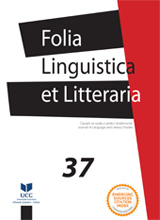О неким ортографским одликама писане грађе из 19. вијека
ON SOME ORTHOGRAPHIC CHARACTERISTICS OF THE WRITTEN MATERIAL FROM THE 19TH CENTURY (ILLUSTRATIONS AND COMMENTS)
Author(s): Sanja ŠubarićSubject(s): Morphology, Historical Linguistics, 19th Century
Published by: Filološki fakultet, Nikšić
Keywords: documents of Montenegrin Senate; Njegos; orthography; consonant groups; morpheme boundaries; separate-word junctions; consonant assimilation by voicing; consonant assimilation by place of articulation
Summary/Abstract: One hundred and seventy years after the death of Petar II Petrovic Njegos, and one hundred and ninety years since he was elected as the head of the Montenegrin state, and, therefore, since the establishment of the Montenegrin Senate, are all the reasons and an important occasion for returning to the written material of the Montenegrin Senate in this paper. The paper is part of a broader linguistic analysis of the documentation of the central and highest state authority in 19th -century Montenegro. It represents an orthographic analysis of the original documents of the Montenegrin Senate (formed at the beginning of the rule of Njegos – 1831) – both as the addresser and the addressee. Specifically, we followed the written reflection of consonant contacts at the morpheme boundaries within words, as well as consonant contacts at the junctions of individual words. Given the number of correspondents of the epistolary communication of the Montenegrin Senate, our analysis reveals the segments of collective orthographic practice from that period in Montenegro. The conclusions about the collective orthographic practice of one period are based on the process of monitoring the spelling procedures of individuals of different literacy levels. In spite of their limitations and, therefore, the limitations of the analysis, it provided the material that helped us discern a collective orthographic trait – a considerable inconsistency in the orthography of consonant groups at the morpheme boundaries within words and relative stability in their orthography at the junction of individual words: in the orthography of consonant groups at the morpheme boundaries within words, two ways of writing are dominant – morphological and phonological, while in the orthography of consonant groups at the junctions of separate words, the morphological principle is mostly established. The same type of orthographic instability was mainly characteristic of the literary expression of the 19th century. This is observable in the comparison of the recorded situation with the data about the orthography of Njegos and with the data on the orthographic procedures of other writers of the time in Montenegro.
Journal: Folia Linguistica et Litteraria
- Issue Year: 2021
- Issue No: 37
- Page Range: 105-134
- Page Count: 30
- Language: Serbian

